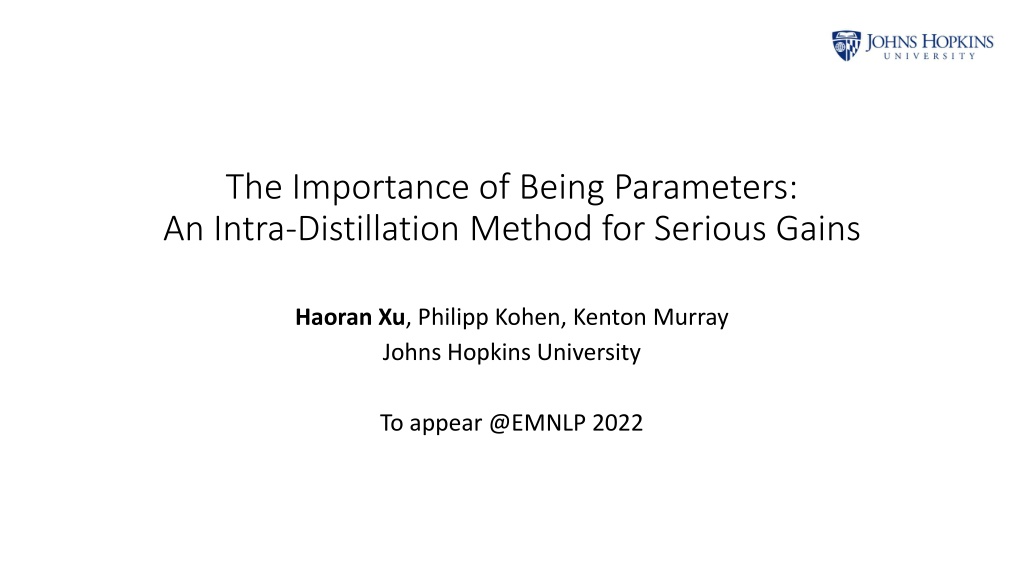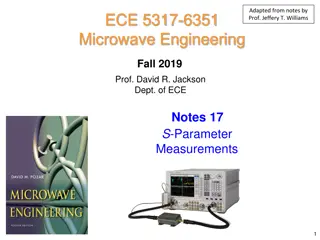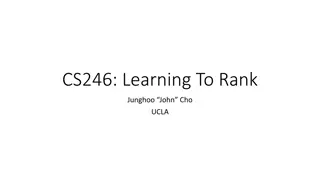Intra-Distillation for Parameter Optimization
"Explore the concept of parameter contribution in machine learning models and discuss the importance of balancing parameters for optimal performance. Introduce an intra-distillation method to train and utilize potentially redundant parameters effectively. A case study on knowledge distillation illustrates methods to achieve balanced parameter contributions."
Download Presentation

Please find below an Image/Link to download the presentation.
The content on the website is provided AS IS for your information and personal use only. It may not be sold, licensed, or shared on other websites without obtaining consent from the author.If you encounter any issues during the download, it is possible that the publisher has removed the file from their server.
You are allowed to download the files provided on this website for personal or commercial use, subject to the condition that they are used lawfully. All files are the property of their respective owners.
The content on the website is provided AS IS for your information and personal use only. It may not be sold, licensed, or shared on other websites without obtaining consent from the author.
E N D
Presentation Transcript
The Importance of Being Parameters: An Intra-Distillation Method for Serious Gains Haoran Xu, Philipp Kohen, Kenton Murray Johns Hopkins University To appear @EMNLP 2022
Introduction Question: Do we overlook possible contribution of redundant parameters? Pruning method have demonstrated the ability to remove redundant parameters without sacrificing model performance. Accuracy 0.95 0.94 Oppositely, we argue that redundant parameters can be properly trained to make beneficial contributions. Accuracy 0.95 0.98 2
Introduction Definition of parameter contribution: We define the contribution of a subset of parameters ?sby its impact on the loss magnitude when the parameters are zeroed-out, which is called sensitivity or importance score widely used in pruning. 3
Introduction Goal: Balance the contribution of all parameters and encourage all of them to contribute equally Contribution of parameters show a great deal of variety. Pruning usually keep top 20% most- sensitive parameters without performance drop . We want to reduce the large contribution gap and no parameters is redundant. 4
A Case Study on Knowledge Distillation What methods that we know can balance the parameter contribution? A well-known method: knowledge distillation. min diff(student, target) + diff(student, teacher) We here investigate a special case of knowledge distillation: self-distillation Ordinary knowledge distillation: Teacher is high-capacity and student is compact. Self-distillation: teacher and student are the same architecture. 5
A Case Study on Knowledge Distillation Iterative self-distillation: distill distill Model 1 Model 2 Model 3 Model 1 is a teacher for Model 2 Model 2 is a new teacher for Model 3 6
A Case Study on Knowledge Distillation A preliminary experiment on a translation task: IWSLT 14 German English Sensitivity Distribution BLEU results Top 20% most sensitive parameters 7
A Case Study on Knowledge Distillation A preliminary experiment on a translation task: IWSLT 14 German English Sensitivity Distribution BLEU results 8
A Case Study on Knowledge Distillation A preliminary experiment on a translation task: IWSLT 14 German English Sensitivity Distribution BLEU results 9
Proposed Method: Intra-Distillation we propose a general method to balance the parameter sensitivity (contribution) to improve the model performance. Intra-Distillation: For the same input, we pass the model multiple times and minimize their difference. Each time we disable different subsets of parameters. 10
Proposed Method: Intra-Distillation Why intra-distillation works? Pass ? Pass ? Two passes activate different subset of parameters 11
Proposed Method: Intra-Distillation Why intra-distillation works? Pass ? Pass ? Both pass use the same red parameters 12
Proposed Method: Intra-Distillation Why intra-distillation works? (see math theory details in the paper!) Pass ? Pass ? Green parameters are different in two passes Minimize the output of two passes, we could approximate minimizing the contribution difference between two green parameters because we want them to do the same thing for the same inputs. 13
Proposed Method: Intra-Distillation Task-Agnostic Implementation: Intra-distillation can be applied to any deep learning tasks. One may notice that it is similar to the objective of knowledge distillation: Loriginal_task + Lintra-distillation is a hyperparameter to control the strength of intra-distillation task loss min difference min diff(student, target) + diff(student, teacher) 14
Experiments We evaluate our intra-distillation on three tasks: Machine Translation Natural Language Understanding Zero-Shot Cross-lingual Transfer Learning For all experiments, we pass the model ? = ? times. Note that we use dropout to simulate disabling random small subset of parameters in each pass. Note that ? = ? with dropout equals to our ordinary training method. 15
Experiments Machine Translation: Low-resource scenario: 8 English-centric language pairs from IWSLT 14 (xx en), 89K-160K data 16
Experiments Machine Translation: Low-resource scenario: 8 English-centric language pairs from IWSLT 14 (xx en), 89K-160K data High-resource scenario: WMT 17 en de, 4.5M data 17
Experiments Natural Language Understanding Fine-tune BERT base model on each task of GLUE 18
Experiments Zero-Shot Cross-Lingual Transfer Learning Low-level task: NER task from Xtreme-R benchmark (48 languages) High-level task: TydiQA (9 languages) We fine-tune XLM-R to conduct both tasks and report averaged results on all languages. 19
Analysis Big gains for three tasks, but is contribution of parameters more balanced actually? Intra-Distillation Iterative Self-Distillation 20
Analysis Big gains for three tasks, but is contribution of parameters more balanced actually? Intra-Distillation Iterative Self-Distillation 21
Analysis How important are those least-sensitive parameters now? Pruning begins with the least-sensitive parameters Intra-distilled model without lower-sensitive parameters degenerates much faster now! 22
Conclusion We use balanced parameter contribution to explain the success of self-distillation We propose a task-agnostic method, intra-distillation, to highly balance the sensitivity (contribution) of model parameters and leads to significantly better generalization performance. Wide-ranging experiments show the effectiveness of intra-distillation. 23
Thank you! 24
Appendix: Effect of number of passes We examine the impact of the number of model passes ?. Continue to previous experiments, we take IWSLT 14 de en as our study objective. ? = 4 performs best. However, the difference is small compared to ? = 3. 25
Appendix: Minimization Function Minimization Function: Given ? outputs {?1,?2, ,??}, minimize their difference. Classification tasks: Regression tasks: 26
Appendix: Sensitivity Approximation After first-order Taylor expansion: Degree of contribution balance: We define the degree of contribution balance to be simply evaluating the standard deviation of all parameter sensitivity. 27
Appendix: Adaptive Intra-Distillation We notice that intra-distillation loss objective will slow down the convergence speed. For instance, in IWSLT 14 German English experiment: Converge slower at the beginning 28
Appendix: Adaptive Intra-Distillation We notice that intra-distillation loss objective will slow down the convergence speed. Here, we design an adaptative algorithm that makes small at the beginning of training and then becomes large afterwards to accelerate the convergence speed 29
Appendix: Adaptive Intra-Distillation We notice that intra-distillation loss objective will slow down the convergence speed. Here, we design an adaptative algorithm that makes small at the beginning of training and then becomes large afterwards to accelerate the convergence speed 30
Appendix: Adaptive Intra-Distillation Setting a proper p, q to the task, e.g., ? = 5,? = 10 in IWSLT 14 German English Intra-distillation now converges faster with adaptive learning! 31























